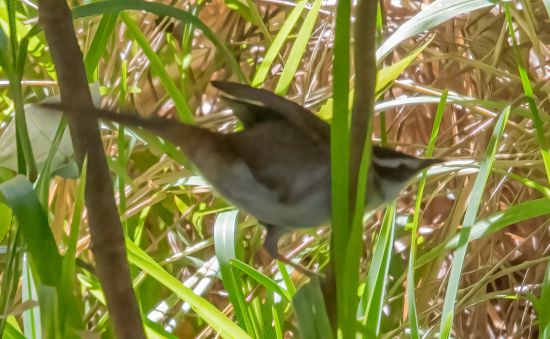(→External Links: Additional sci name added to GSearch) |
|||
| (10 intermediate revisions by 7 users not shown) | |||
| Line 1: | Line 1: | ||
| − | + | {{incomplete}} | |
| − | ;Megalurulus | + | [[File:New Calidonian Thicketbird DS.jpg|thumb|550px|right|Photo © by {{user|Dave+B+Smith|Dave B Smith}}<br />[[New Caledonia]], 15 August 2023]] |
| + | '''Alternative name: New Caledonian Thicketbird''' | ||
| + | ;[[:Category:Cincloramphus|Cincloramphus]] mariei | ||
| + | ''Megalurulus mariei'' | ||
==Identification== | ==Identification== | ||
| − | + | 17-18 cm. <br /> | |
| − | + | Long tail, male and female identical. Upperparts olive-brown; slightly darker and more rufous on crown, wings, and tail; more olive grey on back. Long white eyebrow from the base of the bill to the nape, brown eye-stripe and ear-coverts. Creamy white underparts with a pale-rufous wash, brown flanks, orange at the sides of breast, brown iris brown, black bill, yellow-horn, inside of mouth and throat black. | |
| − | |||
==Distribution== | ==Distribution== | ||
| − | + | [[New Caledonia]] | |
==Taxonomy== | ==Taxonomy== | ||
| − | + | This is a [[Dictionary_M-S#M|monotypic]] species<sup>[[#References|[1]]]</sup>. | |
==Habitat== | ==Habitat== | ||
| − | + | Grassland and open heathlands, lowlands, and hills. | |
==Behaviour== | ==Behaviour== | ||
| − | + | ====Breeding==== | |
| − | + | They nest on the ground, building an open cup of grass and other leaves in dense vegetation. 1 to 3 greyish-white eggs, which are speckled reddish-brown. | |
| + | ====Diet==== | ||
| + | Diet consists mostly of insects. | ||
| + | ==References== | ||
| + | #{{Ref-Clements6thOct23}} | ||
| + | {{ref}} | ||
==External Links== | ==External Links== | ||
| + | {{GSearch|"Cincloramphus mariei" {{!}} "Megalurulus mariei" {{!}} "New Caledonian Grassbird" {{!}} "New Caledonian Thicketbird"}} | ||
| + | {{GS-checked}}1 | ||
| + | <br /> | ||
| + | <br /> | ||
| − | [[Category:Birds]] [[Category: | + | [[Category:Birds]] [[Category:Cincloramphus]] |
Revision as of 12:43, 3 January 2024
| This article is incomplete. This article is missing one or more sections. You can help the BirdForum Opus by expanding it. |
Alternative name: New Caledonian Thicketbird
- Cincloramphus mariei
Megalurulus mariei
Identification
17-18 cm.
Long tail, male and female identical. Upperparts olive-brown; slightly darker and more rufous on crown, wings, and tail; more olive grey on back. Long white eyebrow from the base of the bill to the nape, brown eye-stripe and ear-coverts. Creamy white underparts with a pale-rufous wash, brown flanks, orange at the sides of breast, brown iris brown, black bill, yellow-horn, inside of mouth and throat black.
Distribution
Taxonomy
This is a monotypic species[1].
Habitat
Grassland and open heathlands, lowlands, and hills.
Behaviour
Breeding
They nest on the ground, building an open cup of grass and other leaves in dense vegetation. 1 to 3 greyish-white eggs, which are speckled reddish-brown.
Diet
Diet consists mostly of insects.
References
- Clements, J. F., P. C. Rasmussen, T. S. Schulenberg, M. J. Iliff, T. A. Fredericks, J. A. Gerbracht, D. Lepage, A. Spencer, S. M. Billerman, B. L. Sullivan, and C. L. Wood. 2023. The eBird/Clements checklist of Birds of the World: v2023. Downloaded from https://www.birds.cornell.edu/clementschecklist/download/
Recommended Citation
- BirdForum Opus contributors. (2025) New Caledonian Grassbird. In: BirdForum, the forum for wild birds and birding. Retrieved 2 January 2025 from https://www.birdforum.net/opus/New_Caledonian_Grassbird
External Links
GSearch checked for 2020 platform.1




